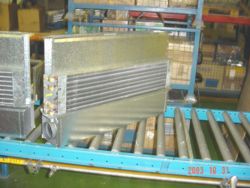A revival for induction units

Induction units for air conditioning are enjoying a return to popularity in the UK — especially in refurbishment projects.
Using induction systems to air condition a building may seem old fashioned today, but it can be the ideal solution for a range of applications, according to ROMAN NEMECZEKThe air conditioning industry has moved on a long way since the 1970s and somewhere along the road induction units got left behind. A lot of that was to do with space restrictions and changing office layouts. Induction systems tend to be placed around the perimeter of the occupied space, so the fashion quickly changed to putting air conditioning in the ceiling. Also, the proliferation of heavily glazed facades means that induction units have to be made extremely low or removed altogether for aesthetic reasons. So split systems, fan coils and, later, VRV have come to dominate the market — leaving induction systems out in the cold.
Ironies However, one of the industry’s great ironies is that chilled beams operate on exactly the same principle as induction units — inducing air through cooling coils and delivering it to the occupied space via nozzles. This kind of approach is proving extremely popular with consulting engineers, who use chilled beams to deliver energy-efficient and environmentally friendly solutions — achieving a similar result to that achieved by induction units over 40 years ago. Induction units have been installed above the ceiling in many buildings throughout Europe, but remain a little recognised phenomenon in the UK. Induction units contain no moving parts and can deliver fresh air in a highly energy-efficient way without the need for separate air-handling plant for fresh air. There is a dangerous myth around the industry that induction systems are no longer available — hence the expensive decision made by many specifiers to rip out old installations and replace them with fan-coil units. Fan coils are an excellent solution in many instances, but require considerable fan power to move tempered air around the space — and that means energy.
Mini-revival Lennox has experienced a mini-revival in induction technology, with a number of lucrative contracts to replace old installations. With the acquisition of Refac in 1999, Lennox gained access to one of the leading ranges of induction systems — along with engineering expertise in this market area and a wide portfolio of existing customers. Induction units will continue working for 20 to 25 years. At that stage, it is better to look at replacement rather than repair, particularly if they have been operating in heavily polluted city environments.
Replace It is at this point that many systems have simply been dumped in favour of more ‘modern’ solutions, but New Scotland Yard, in contrast, was delighted to discover it could still replace its popular system when the building was refurbished. As a result, Lennox supplied over 1500 units for this famous headquarters of the Metropolitan Police. The units for this project had to be specially modified to be less than 350 mm high because of the new glazing. Marble Arch Tower is another recipient of the induction approach, with 500 units delivered recently. That contract was secured because Lennox could deliver 430 units in four weeks from the order — against other estimates of 16 weeks. The products selected for the Hammersmith refurbishment are Inductair MGD-64 units with integral dampers for balancing primary air balancing, 100 mm-diameter connections for primary air and lint screen filters. Lennox is providing a complete design, manufacture and commissioning service to ensure the primary airflow is balanced to achieve high performance from the system. The Unilever headquarters in Rotterdam has over 1500 induction units installed above the ceiling. They were delivered with valves and supply grilles fitted ready for installation, reducing site costs. Air induction may no longer be a fashionable method for air conditioning in office buildings, but it is still effective and retains many design and running benefits. It is, therefore, short sighted to simply assume that when these systems come to the end of their working life they have to be ripped out and replaced with a new type of system. It is still possible to replace like-for-like, keeping down rebuilding costs. Induction units are also relatively low cost compared to other systems. With the advent of tighter restrictions on facade designs to reduce energy penalties under the EU Energy Performance of Buildings Directive, we may soon see a backlash against the widespread use of floor-to-ceiling glazing — opening up new possibilities for induction air conditioning. There is life in induction yet.
Roman Nemeczek is with Lennox UK, PO Box 174, Northampton NN4 7EX.
Related links:


